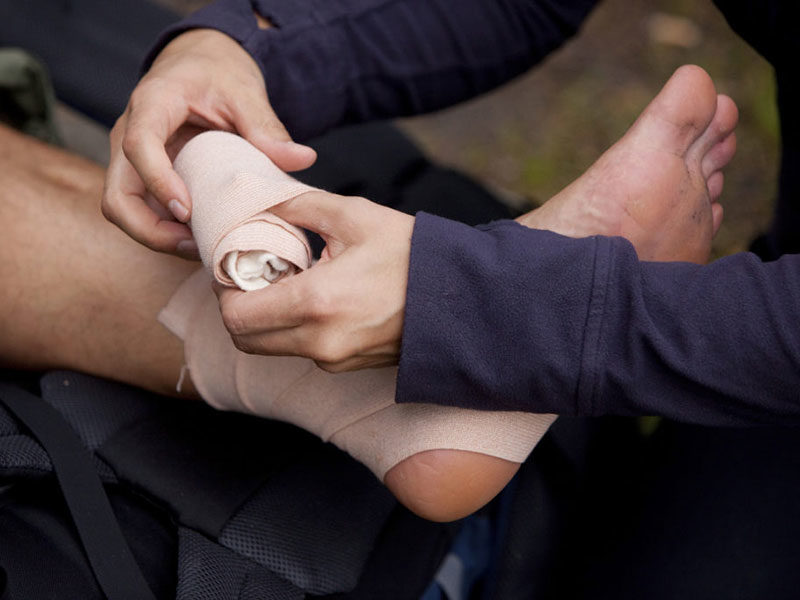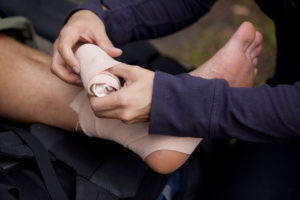Broken bones and sprains: what’s the difference?
A sprain is a twisting or wrenching of the ligaments of a joint. A sprain will cause pain and swelling without dislocation. Broken bones are also referred to as a fracture. Any crack in a bone is a fracture. There are different types of fractures, from a stress fracture (a small crack in the bone from repeated or prolonged force) to a compound fracture (a broken bone that punctures the skin).
How can you tell if an injury is a sprain or a broken bone?
The symptoms for these two injuries are very similar, but there are few clues you can use to figure out which type of injury has been sustained. If the victim heard a noise when the injury occurred, a cracking sound indicates a break, while a popping sound is more commonly associated with a sprain. If the injured area appears deformed or crooked in addition to the swelling, or if there is any numbness, it’s likely a break. Follow up with a doctor will remove any doubt about the nature of the injury.
Sprains and broken bones can be painful. Since not all sprains or breaks require emergency medical attention, it’s important to know what to do to provide first aid, and what to look for in case the victim needs immediate help. If you or someone you know has injured themselves, follow these easy steps to help render aid.
- Control swelling with RICE therapy. RICE stands for:
- Rest and immobilize the injured body part. If you can, use a sling for an arm injury, or crutches for a foot or leg injury. If a finger or toe has been injured, you can tape it to an adjacent finger or toe, which will work as a splint.
- Ice for 20 minutes on, 20 minutes off, ideally for the first 48 hours. Never put ice in direct contact with skin. Use a towel or piece of cloth to protect the skin.
- Compress by wrapping the injured body part. An elastic bandage, or piece of cloth can work to compress the injury.
- Elevate the injured area above the heart.
- Manage pain and inflammation.
- Give an over the counter NSAID (Non-Steroidal Anti-Inflammatory Drug) such as ibuprofen (Advil, Motrin), acetaminophen (Tylenol), naproxen (Aleve), or aspirin. Do not give aspirin to anyone under 19 years of age. Aspirin has been linked to an increased risk of developing Reye’s Syndrome in people under 19.
- Seek medical attention.
- All but the most minor sprains should be assessed by a doctor. It’s important that the doctor screen to make sure the injury will heal properly and not have lasting effects.
- Follow up.
- Continue R.I.C.E. for 48 hours, or until the injured person sees a doctor.
- The doctor may want to get an X-ray or an MRI to properly diagnose the injury.
- The doctor may need to immobilize the injured limb or joint with a cast, splint, or other device. Physical therapy can also be helpful for a full recovery.
- In severe cases of sprain, surgery may be needed.
If you suspect a broken bone, it’s important to seek medical attention. An appointment with your doctor or an urgent care visit will suffice for most broken bones. You do not need to call 9-1-1 for emergency help for a broken bone unless:
- The person has passed out or is not responding.
- The person isn’t breathing or moving. Call for help and administer CPR.
- The injury is to the back, neck, hip, or upper leg.
- The limb or joint looks disfigured.
- Even gentle pressure or movement causes pain.
- The person is bleeding heavily.
- The broken bone has pierced the skin and is visible.
- The fingers or toes of the victim are numb, cold, or blue at the tips.
Remember, if you suspect a broken bone and the victim needs emergency medical attention, don’t move the person except if absolutely necessary to avoid further injury. While you are waiting for help to arrive, you can still provide aid.
- Apply pressure to open wounds to stop bleeding.
- Immobilize the injured area.
- Apply ice packs (if available) to help reduce swelling and relieve pain.
- Treat for shock by having the person lie down, with their head slightly lower than their body and elevate their legs if it does not cause the cause further pain. If it is available, cover the person with a blanket.


